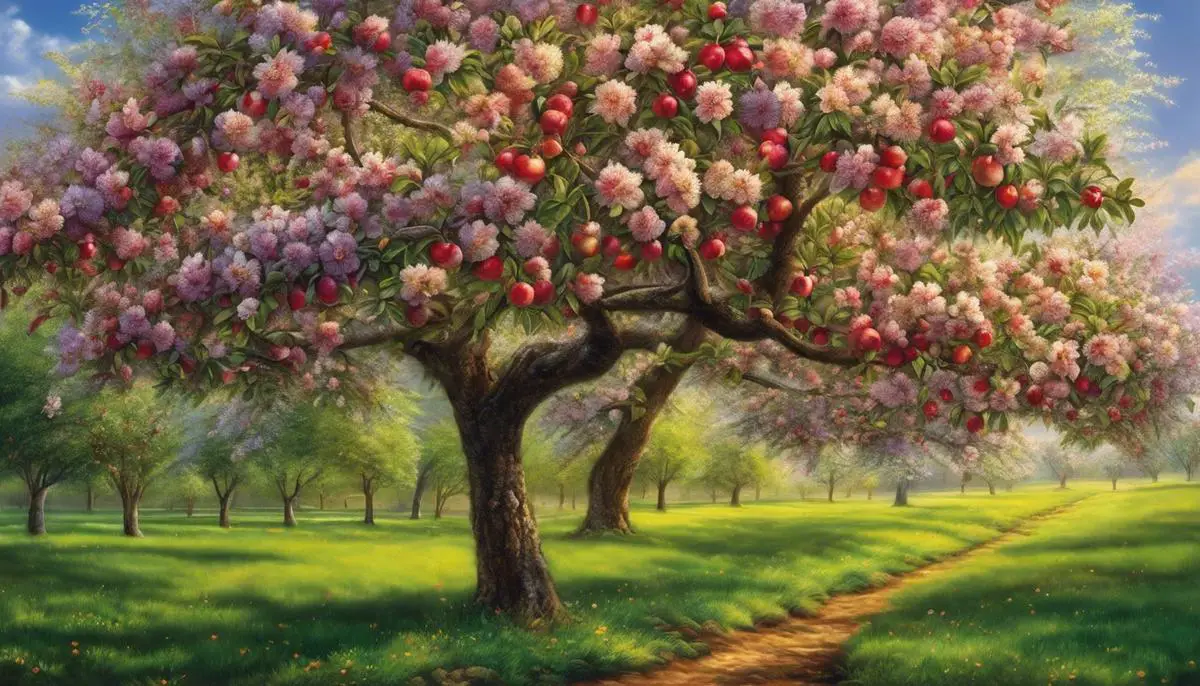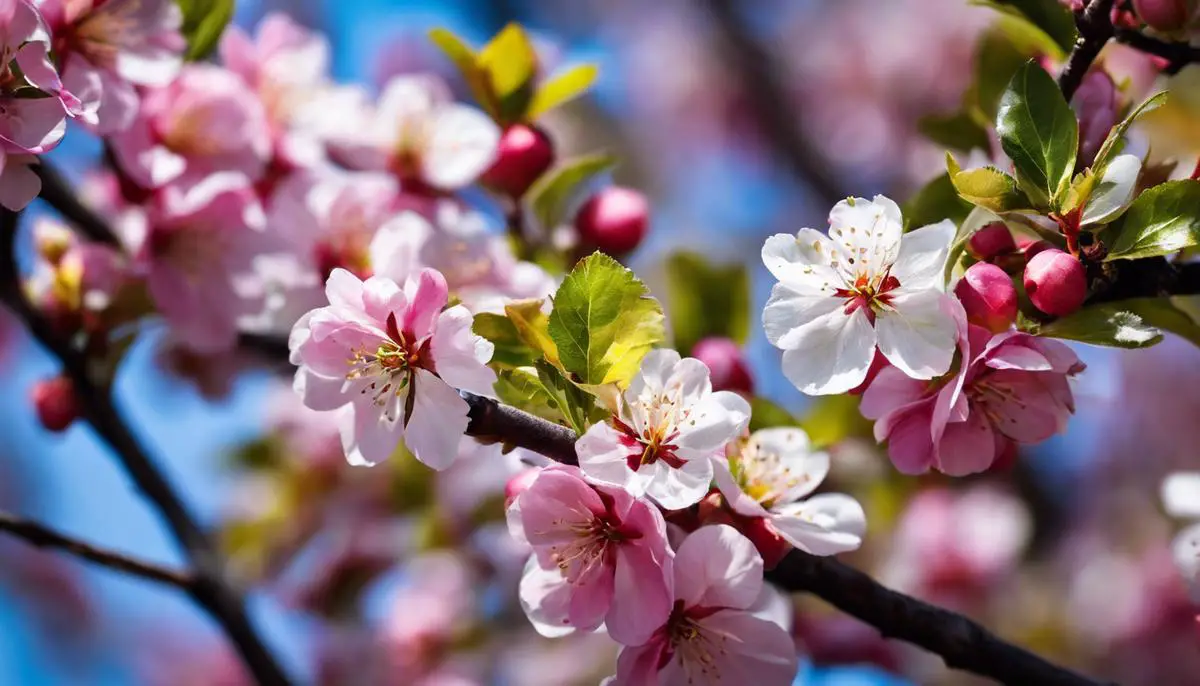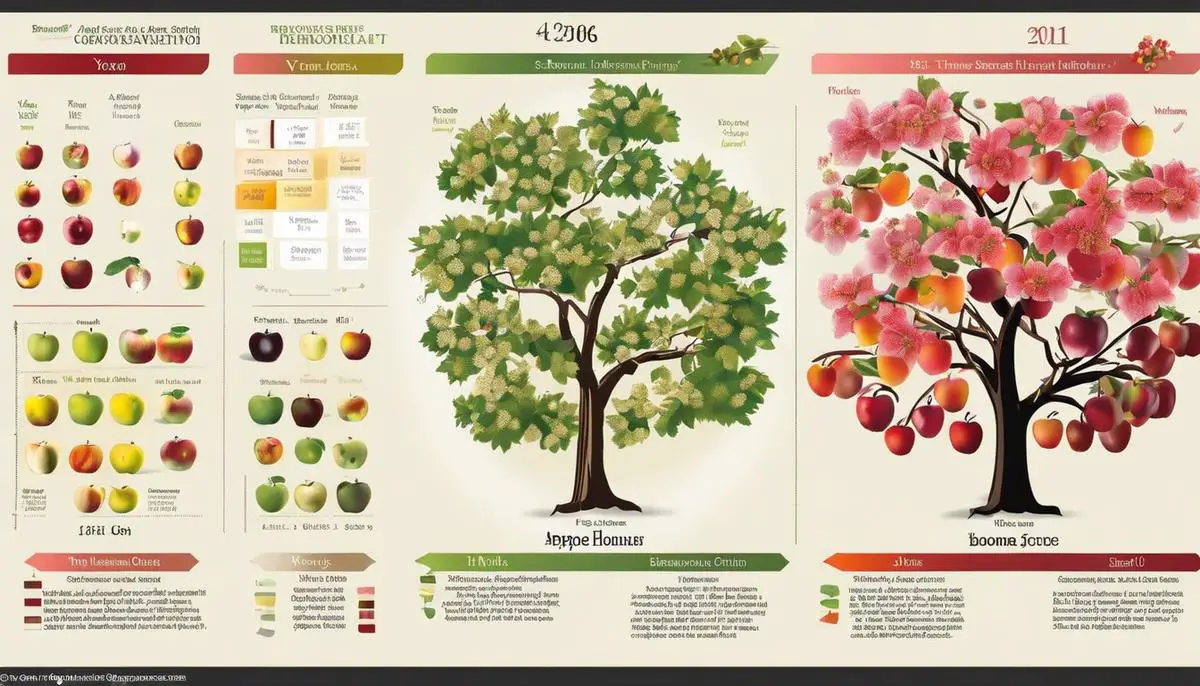Embarking on the fascinating journey of understanding the varied world of apple trees, we delve into the intricate details of diverse apple tree varieties across different geographical locations. Different apple trees possess unique blooming periods and traits, making each one a wonder in itself. By comprehending their specific blooming times, we can execute precise and beneficial tree care practices. In addition to studying the trees themselves, we also explore the process of creating an inclusive apple tree bloom time chart. Such a chart employs considerations of climate, health of the tree and particular habits of the apple tree variety.
Understanding Different Apple Tree Varieties
Savvy to the Core: Varieties of Apple Trees and their Bloom Times
In the wonderful world of apples, there’s a fantastic array of trees to choose from. Whether nurturing a fledgling orchard in a backyard or ardently studying all things apple-related, understanding the major varieties and their bloom times is key. Here’s a snapshot of the apple rainbow and when to expect those splendid blossoms.
-
McIntosh
The McIntosh Apple tree will win hearts with its servings of deliciously crisp and mildly tart fruits. Often home-grown in Northern cold areas, McIntosh are usually among the first trees to bloom in the spring. Their bloom time is typically between late April to early May. It’s worth noting though, these apples will only be ready to harvest near late September or early October.
-
Granny Smith
Beloved for their tartness, the Granny Smith is an apple tree variety that blooms a little later in mid to late spring. With its origin tracing back to Australia, this tree is accustomed to milder climates. Hence, it’s often grown in the warmer southern regions of the United States. The Granny Smith’s apples are often harvested in late October through November.
-
Fuji
An apple tree variety hailing from Japan, Fuji trees are known for their late bloom period, often in May. These trees prefer warmer climates and can take longer to mature. Yet, patience is rewarded with their extra-juicy and super-sweet apples. These fruits are typically harvested in October.
-
Honeycrisp
The name says it all about the Honeycrisp apples. The tree’s capacity to thrive in colder as well as warm climates adds to its immense popularity among apple enthusiasts. The Honeycrisp tree enters its bloom time a bit later, usually between late April and early May. Yet, despite its late blooming, the Honeycrisp apples are usually ready for harvest by mid to late September.
-
Gala
Rounding off our list is the Gala apple tree, a New Zealand native loved worldwide. This tree typically blooms earlier than other varieties, often welcoming spring with its blossoms in April. Its ability to adapt to multiple climates contributes to its widespread growing. Also, Gala apples usually mature faster than other varieties, being ready for harvest in late summer to early autumn.
In conclusion, the apple world is wonderfully diverse with trees blooming at different times, depending on their variety and location. While this guide has shared information about five major varieties of apple trees, there are countless more to explore. Choosing an apple tree variety is almost as delectable as biting into a fresh, juicy apple plucked straight from the tree. Happy apple growing!

Creating an Apple Tree Bloom Time Chart
Explore the World of Apple Tree Blooming: Spotlight on Pink Lady, Cortland, and Red Delicious
Gardening enthusiasts always enjoy witnessing the bloom times of their favorite plants, but in no situation does the sight hold more anticipation than with apple tree cultivation. On this journey, we’ve traversed the bloom cycles of the McIntosh, Granny Smith, Fuji, Honeycrisp, and Gala apple trees. Now, let’s yield to the beauty of the Cortland, Red Delicious, and Pink Lady apple trees.
Diving right into the meticulous yet delightful regimen of apple tree cultivation, let’s focus on the popular unique variety known as the Cortland apple tree. This American classic, developed in New York in the 1890s, is loved for its juicy red apples and its late bloom. Generally, the Cortland apple tree sets its first blooms in late April to early May, its lush petals casting a picturesque spell throughout your garden.
Shifting focus to the Red Delicious apple tree, this iconic variety is yet another exciting specimen to follow. Unmistakable for its crimson, heart-shaped apples, Red Delicious trees boast a bloom time typically falling in the mid-season period. That could mean any time from late April to early May in most North American climates. What’s truly magnificent about this variety is the sight of its pinkish-white blossoms against the deep green of its leaves — surely a spectacle to behold.
Finally, let’s turn our gaze towards the Pink Lady, or Cripps Pink, apple tree — a late blooming variety that waits until the majority of apple trees have displayed their spring spectacle before making a grand entrance. These trees often entrance onlookers with their blossoms in mid to late May. This is an advantage in regions prone to late spring frosts, adding an extra buffer of protection for these promising buds.
In the same way that no two apples are alike, no two apple tree cultivars share the exact same bloom time. Understanding the unique bloom cycles of Cortland, Red Delicious, and Pink Lady apple trees will allow any hobbyist to schedule an effective apple tree cultivation routine. Whether you’re a seasoned apple cultivator, or someone just starting to dabble in the hobby, these insights are sure to contribute to an enriching and successful apple gardening story. Welcome the hum of bees and the scent of blossoms drifting in the air, and let’s continue our fascinating journey into the world of apple tree cultivation.

Interpreting and Applying a Bloom Time Chart
Apple tree bloom time charts are a tracked historical record of the blooming periods of apple tree varieties. By assessing and understanding these cycles, cultivators can better provide for the health and yield capabilities of their fruit trees – a task that could yield fruitful, quite literally, results.
But how are these charts practically used and why do they matter for the health and yield of the trees? Let’s dive in.
It’s important, first, to understand the mating habits of apple trees. The male parts of the apple flower produce pollen, and this pollen needs to reach the female parts of another flower (ideally from a different variety of apple) for fertilization to occur. This cross-pollination process results in fruit. This is where different apple tree bloom times become significant. If the trees you’re growing don’t bloom at the same time, pollination, and subsequently, a productive fruit harvest may become challenging.
By being aware of the varietal bloom times, you can wisely pair different apple tree breeds to ensure coactive blooming. A tree like the late-blooming Pink Lady, for instance, could be paired with other late bloomers like Granny Smith trees for a fruitful cross-pollination period. Conversely, avoiding the planting of an early blooming McIntosh tree alongside a late bloomer, like Madame Cripps, mitigates risk of a barren tree—a fruitful tip from the chart!
Pruning, a key activity in tree health and fruit yield, can also be aided by bloom time charts. Why? Bloom times can signal the recovery and regrowth period of a tree after it’s pruned. If a Cortland apple tree, for example, is pruned too close to its bloom time, recovery might be compromised and blooming could be diminished. Therefore, knowing when ‘pruning recovery time’ aligns with ‘bloom time’ is critical in influencing the tree’s health.
Bloom time charts can act as your planting guide in regions prone to late frost. Late blooming varieties like Cripps Pink or Fuji are better suited to these regions, while early bloomers like the Red Delicious are more at risk.
In conclusion, using a bloom time chart allows for careful selection and pairing of apple tree varieties, informed pruning schedules along with ideal geographic planting decisions, all culminating in optimum tree health and plentiful apple yields. As you delve deeper into the exciting world of apple cultivation, keeping a keen eye on bloom time charts could be your secret weapon to a thriving, fruitful orchard. Enjoy the ride and let the apples fall where they may, once they’ve bloomed on time of course!

As we find ourselves enlightened with the knowledge of diverse apple tree varieties and their blooming periods, the use and interpretation of a bloom time chart become second nature. This tool, laden with valuable information, guides us in implementing proper tree care routines such as watering, pruning, and pest control. Effectively utilizing an apple tree bloom time chart requires understanding the trees’ specific stages of blooming and adjusting our actions accordingly. The realm of apple trees is rich and captivating, inviting us to be more involved and aware, thereby fostering healthier trees and, ultimately, a healthier planet.
